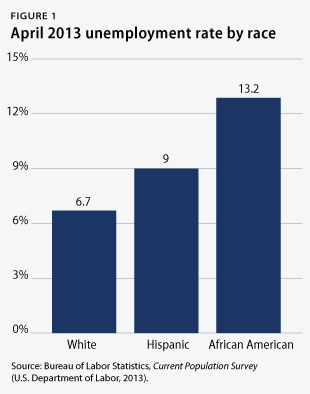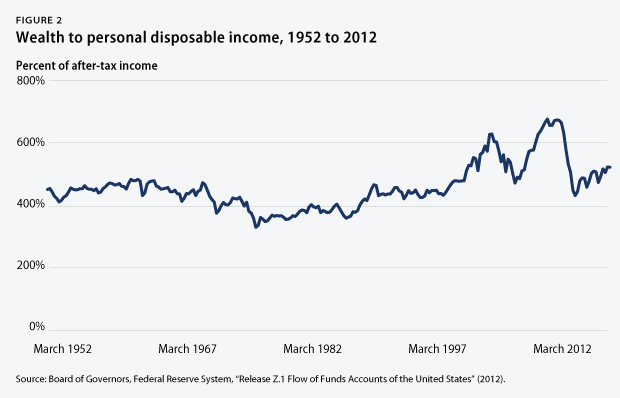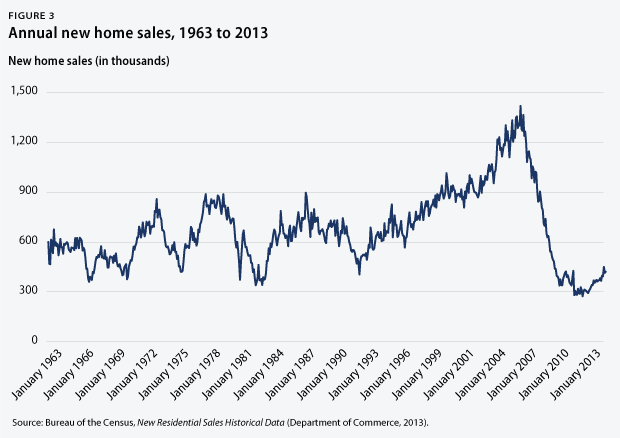Amid the current economic recovery, closing in on the end of its fourth year, policymakers must remain vigilant and look out for persisting and newly emerging threats to economic and job growth. Both the economy and the labor market are slowly improving, held back by persisting factors such as states’ fiscal struggles, European financial troubles, and high household debt, as well as newly emerging threats such as the across-the-board federal spending cuts known as sequestration.
Policymakers not only need to be vigilant for factors that hold back economic and job growth, but they also need to learn their lessons about what works and what doesn’t. The past few years since the start of the Great Recession at the end of 2007 have seen several policy interventions that brought the economy back from the brink of a depression, saved the financial system from completely cratering, and helped save and create millions of jobs. Now it is time to consider additional policy measures to bring down unemployment and economic suffering from their still-too-high levels. Such measures should include, as a start, replacing sequestration with a balanced approach to long-term deficit reduction comprised of slower spending growth and more revenue, much-needed infrastructure investments to lower the costs of doing business, and an increase in the minimum wage to support those Americans struggling the most.
1. Economic growth picked up at the beginning of 2013. Gross domestic product, or GDP, increased in the first quarter of 2013 at an annual rate of 2.5 percent. Domestic consumption increased by an inflation-adjusted annual rate of 3.2 percent, housing spending grew by 12.6 percent, and business investment accelerated moderately by 2.1 percent. Exports grew by 2.8 percent in the first quarter, but government spending shrank again by 4.1 percent. Policy solutions should therefore aim to ease the strain of fiscal austerity on the economy by replacing across-the-board spending cuts with a balanced approach of slower spending growth and revenue increases.
2. The moderate labor market recovery continues in its fourth year. There were 4.9 million more jobs in April 2013 than in June 2009, when the economic recovery officially started. The private sector added 5.6 million jobs during this period. The loss of nearly 695,000 state and local government jobs explains the difference between the net gain and the private-sector gain in this period, as budget cuts reduced the number of teachers, bus drivers, firefighters, and police officers, among others. Job creation should be a top policy priority since private-sector job growth is still too weak to quickly overcome other job losses and rapidly lower the unemployment rate. Once again, removing the uncertainty over fiscal changes is a key step toward strengthening economic and job growth.
3. Long-term unemployment stays high, and some communities continue to struggle disproportionately from unemployment. The unemployment rate stood at 7.5 percent in April 2013, and 37.4 percent of the unemployed had been out of work for at least six months. Those out of a job for a long time struggle to regain employment because their skills atrophy. In April the African American unemployment rate was 13.2 percent, the Hispanic unemployment rate was 9 percent, and the white unemployment rate was 6.7 percent. Meanwhile, youth unemployment stood at 24.1 percent. The unemployment rate for people without a high school diploma ticked up to 11.6 percent, compared to 7.4 percent for those with a high school degree, 6.4 percent for those with some college education, and 3.9 percent for those with a college degree. These population groups with higher unemployment rates have struggled disproportionately more amid the weak labor market than white workers, older workers, and workers with more education. This creates a greater need for progressive policy actions to strengthen job creation for everybody.

4. The rich continue to pull away from most Americans. Incomes of households in the 95th percentile—with incomes of $186,000 in 2011, the most recent year for which data are available—were more than nine times the incomes of households in the 20th percentile, whose incomes were $20,262. This is the largest gap between the top 5 percent and the bottom 20 percent of households since the U.S. Census Bureau started keeping record in 1967. Median inflation-adjusted household income stood at $50,054 in 2011, its lowest level in inflation-adjusted dollars since 1995. And the poverty rate remains high, at 15 percent in 2011, as the economic slump continues to take a massive toll on the most vulnerable citizens.
5. Employer-sponsored benefits disappear. The share of people with employer-sponsored health insurance dropped from 59.8 percent in 2007 to 55.1 percent in 2011, the most recent year for which data are available. The share of private-sector workers who participated in a retirement plan at work fell to 39.2 percent in 2011, down from 42 percent in 2007. Families now have less economic security than in the past due to fewer employment-based benefits, which requires that they have more private savings to make up the difference.
6. Family wealth losses still linger. In December 2012 total family wealth was down $8.4 trillion (in 2012 dollars) from March 2007, its last peak. Homeowners on average own only 46.6 percent of their homes—compared to the long-term average of 61 percent before the Great Recession—with the rest owed to banks. Homeowners’ massive debt slows household spending growth, as households still have little collateral for banks to loosen their lending standards and households spend less than they otherwise would on new homes and other big-ticket items.
7. Household debt is still high. Household debt equaled 105.5 percent of after-tax income in December 2012, down from a peak of 126 percent in March 2007. The unprecedented fall in debt over the past few years is a result of tighter lending standards, falling interest rates, massive foreclosures, and increased household saving. But unless incomes rise faster than they have in the past, further deleveraging will likely slow since most factors that helped reduce household debt in the past have slowed or disappeared, such as falling interest rates and the payroll tax holiday. This high debt could continue to slow economic growth as households focus on saving rather than on spending.
8. The housing market continues to recover from historic lows. New home sales amounted to an annual rate of 417,000 in March 2013—an 18.5 percent increase from the 352,000 homes sold in March 2012 but well below the historical average of 698,000 homes sold before the Great Recession. The median new home price in March 2013 was 3 percent higher than one year earlier. Existing home sales were up by 10.3 percent in February 2013 from one year earlier, and the median price for existing homes was up by 11.8 percent during the same period. Home sales have to go a lot further, given that homeownership in the United States stood at 65 percent in the first quarter of 2013, down from 68.2 percent before the crisis. The current homeownership rates are similar to those recorded in 1995, well before the most recent housing bubble started. The housing market could potentially grow and contribute to economic progress because the recovery in the spring of 2012 started from historically low home sales and the housing market fell throughout most of the recovery. The fledgling housing recovery could gain further strength if policymakers focus on personal income gains in the near term.
9. Homeowners’ distress remains high. Even though mortgage troubles have gradually eased since March 2010, nearly one in nine mortgages is still delinquent or in foreclosure. In the fourth quarter of 2012, the share of mortgages that were delinquent was 7.1 percent, and the share of mortgages that were in foreclosure was 3.7 percent. Many families delayed and defaulted on mortgage payments amid high unemployment and massive wealth losses. This caused some banks to be nervous about extending new mortgages, which further prolonged the economic slump. Policymakers can accelerate economic growth by helping households lower their debt burdens through refinancing help and debt forgiveness.

10. Corporate profits stay high near pre-crisis peaks. Inflation-adjusted corporate profits were 85.2 percent larger in December 2012 than in June 2009, when the economic recovery started. The after-tax corporate profit rate—profits to total assets—stood at 3.1 percent in December 2012, nearing the previous peak after-tax profit rate of 3.2 percent that occurred prior to the Great Recession.
11. Slow productivity growth marks the U.S. economy. Productivity growth is the main ingredient in rising living standards. Wages, jobs, and profits depend on workers and companies figuring out how to make more and better things in the same amount of time. Output per hour, the main measure of productivity growth, has expanded by 7.5 percent from December 2007, when the Great Recession started, to March 2013, the last quarter for which data are available. This is substantially less than the average productivity growth of 8.9 percent during the same periods in previous business cycles of equal or greater length.

12. Budget deficits decline. The nonpartisan Congressional Budget Office, or CBO, estimated in February 2013 that the federal budget deficit for fiscal year 2013—running from October 1, 2012, to September 30, 2013—will amount to 5.3 percent of GDP, down from 7 percent in fiscal year 2012. The projected deficit for FY 2013 is somewhat worse than CBO anticipated in August 2012, when it estimated a deficit of 4 percent of GDP for FY 2013, in large part because of the Bush tax cuts that were put permanently into law at the beginning of 2013 to avoid the so-called fiscal cliff. The estimated deficit for FY 2013 is still much smaller than it was in previous years, however, due to a number of measures that policymakers have already taken to slow the growth of spending and raise a little more revenue than was expected just last year.
Christian E. Weller is a Senior Fellow at the Center for American Progress and a professor in the Department of Public Policy and Public Affairs at the McCormack Graduate School of Policy and Global Studies at the University of Massachusetts Boston. Sam Ungar is a Special Assistant at the Center.